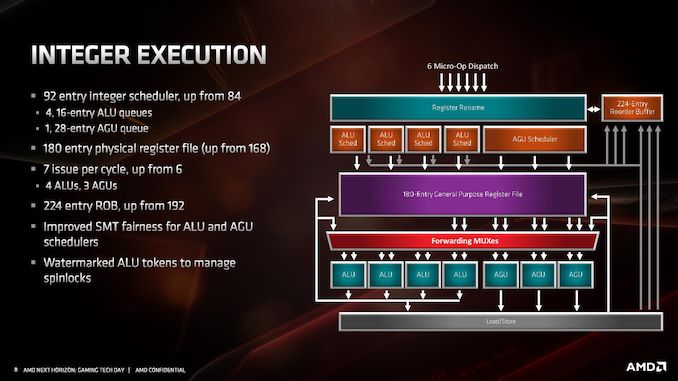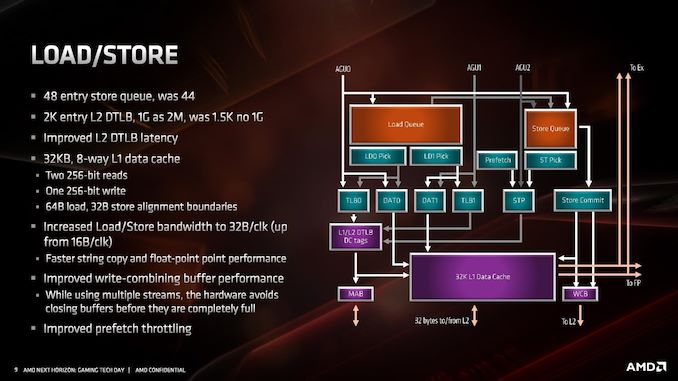AMD Zen 2 Microarchitecture Analysis: Ryzen 3000 and EPYC Rome
by Dr. Ian Cutress on June 10, 2019 7:22 PM EST- Posted in
- CPUs
- AMD
- Ryzen
- EPYC
- Infinity Fabric
- PCIe 4.0
- Zen 2
- Rome
- Ryzen 3000
- Ryzen 3rd Gen
Integer Units, Load and Store
The integer unit schedulers can accept up to six micro-ops per cycle, which feed into the 224-entry reorder buffer (up from 192). The Integer unit technically has seven execution ports, comprised of four ALUs (arithmetic logic units) and three AGUs (address generation units).
The schedulers comprise of four 16-entry ALU queues and one 28-entry AGU queue, although the AGU unit can feed 3 micro-ops per cycle into the register file. The AGU queue has increased in size based on AMD’s simulations of instruction distributions in common software. These queues feed into the 180-entry general purpose register file (up from 168), but also keep track of specific ALU operations to prevent potential halting operations.
The three AGUs feed into the load/store unit that can support two 256-bit reads and one 256-bit write per cycle. Not all the three AGUs are equal, judging by the diagram above: AGU2 can only manage stores, whereas AGU0 and AGU1 can do both loads and stores.
The store queue has increased from 44 to 48 entries, and the TLBs for the data cache have also increased. The key metric here though is the load/store bandwidth, as the core can now support 32 bytes per clock, up from 16.












216 Comments
View All Comments
Teutorix - Tuesday, June 11, 2019 - link
If TDPs are accurate they should reflect power consumption.If a chip needs 95W cooling it's using 95W of power. The heat doesn't come out of nowhere.
zmatt - Tuesday, June 11, 2019 - link
I think technically it would be drawing a more than its TDP. The heat generated by electronics is waste due to the inefficiency of semi conductors. If you had a perfect conductor with zero resistance in a perfect world then it shouldn't make any heat. However the TDP cannot exceed power draw as that's where the heat comes from. How much TDP differs from power draw would depend on a lot of things such as what material the semiconductor is made or, silicon, germanium etc. And I'm sure design also factors in a great deal.If you read Gamers Nexus, they occasionally measure real power draw on systems, https://www.gamersnexus.net/hwreviews/3066-intel-i...
And you can see that draw massively exceeds TDP in some cases, especially at the high end. This makes sense, if semiconductors were only 10% efficient then they wouldn't perform nearly as well as they do.
Teutorix - Tuesday, June 11, 2019 - link
"I think technically it would be drawing a more than its TDP"Yeah, but if a chip is drawing more power than its TDP it is also producing more heat than its TDP. Making the TDP basically a lie.
"The heat generated by electronics is waste due to the inefficiency of semi conductors. If you had a perfect conductor with zero resistance in a perfect world then it shouldn't make any heat"
Essentially yes, there is a lower limit on power consumption but its many orders of magnitude below where we are today.
"How much TDP differs from power draw would depend on a lot of things such as what material the semiconductor is made or, silicon, germanium etc. And I'm sure design also factors in a great deal."
No. TDP = the "intended" thermal output of the device. The themal output is directly equal to the power input. There's nothing that will ever change that. If your chip is drawing 200W, its outputting 200W of heat, end of story.
Intel defines TDP at base clocks, but nobody expects a CPU to sit at base clocks even in extended workloads. So when you have a 9900k for example its TDP is 95W, but only when its at 3.6GHz. If you get up to its all core boost of 4.7 its suddenly draining 200W sustained assuming you have enough cooling.
Speaking of cooling. If you buy a 9900k with a 95W TDP you'd be forgiven for thinking that a hyper 212 with a max capacity of 180W would be more than capable of handling this chip. NOPE. Say goodbye to that 4.7GHz all core boost.
"If you read Gamers Nexus, they occasionally measure real power draw on systems, https://www.gamersnexus.net/hwreviews/3066-intel-i...
And you can see that draw massively exceeds TDP in some cases, especially at the high end. This makes sense, if semiconductors were only 10% efficient then they wouldn't perform nearly as well as they do."
None of that makes any difference. TDP is supposed to represent the cooling capacity needed for the chip. If a "95W" chip can't be sufficiently cooled by a 150W cooler there's a problem.
Both Intel and AMD need to start quoting TDPs that match the boost frequencies they use to market the chips.
Cooe - Tuesday, June 11, 2019 - link
... AMD DOES include boost in their TDP calculations (unlike Intel), and always have. They make their methodology for this calculation freely available & explicit.Spoelie - Wednesday, June 12, 2019 - link
Look at these power tables for 2700Xhttps://www.anandtech.com/show/12625/amd-second-ge...
=>You are only hitting 'TDP' figures at close to full loading, so "frequency max" is not limited by TDP but by the silicon.
=>Slightly lowering frequency *and voltage* really adds up the power savings over many cores. The load table of the 3700 will look on the whole different than for the 3600X. The 3700 will probably lose out in some medium threaded scenarios (not lightly and not heavily threaded)
Gastec - Wednesday, June 12, 2019 - link
That's not actually the real power consumption. Most likely you will get a 3700X with 70-75 W (according to the software app indications) but a bit more if tested with a multimeter. Add to that the inefficiency of the PSU, say 85-90%, and you have about 85 W of real power consumption. Somewhat better than my current 110W i7-860 or the 150+W Intel 9000 series ones I would say :)xrror - Monday, June 10, 2019 - link
funny you say that. AMD TDP and Intel TDP differ. I think.HEY IAN, does AMD still measure TDP as "real" (total) dissipation power or Intel's weaksauce "Typical" dissipation power?
Teutorix - Tuesday, June 11, 2019 - link
Intel rate TDP at base clocks. AMD do something a little more complex.Neither of them reflect real world power consumption for sustained workloads.
FreckledTrout - Tuesday, June 11, 2019 - link
In desktops they are simply starting points for the cooling solution needed. They do a lot better in the laptop/tablet space where TDP's make or break designs.Cooe - Tuesday, June 11, 2019 - link
Yes they do. A 2700X pulls almost exactly 105W under the kind of conditions you describe. Just because Intel's values are completely nonsense doesn't mean they all are.